
|   |

|   |
Dancejathre 2020 - as the journey continues... - Dr. Hareesh N. Nampoothiri e-mail: newn.haree@gmail.com Photos: Haree Fotografie February 25, 2020 'Dancejathre' is conceived as a banquet serving to both practitioners and viewers alike. A brainchild of Kuchipudi exponent Vyjayanthi Kashi, the two-day gala was organized by her institute Shambhavi School of Dance in Bengaluru. Contests, exhibitions, lecture demonstrations along with workshops and group performances by seasoned artists formed the content. Organizing such a multi-faceted event is no easy task. However, the experience over the years has made the organizers equipped with all that is needed to make running the show look easy. Whether it's the workshops or the performances or the contests, what made it all worth was the genuineness. Rather than having everything for the sake of it, it brought together different sections together to experience it. The festival had something in the offer for everyone, no matter whether you are a novice dancer or somebody who has made it a profession or a spectator. A shift in approach 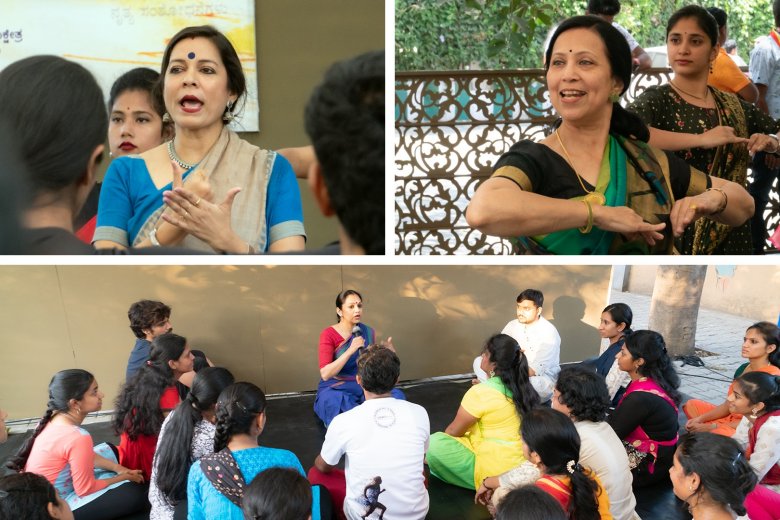 Workshops at the festival were for those who have been practicing dance for at least a few years. The challenge for the mentors was to share with the participants, something meaningful, in the limited time of an hour. Sure, all of them being experienced artists had much more to offer than what they could do it in the short span. However, the advantage was rather than teaching a new item or making them practice some adavus, which happens normally in workshops these days, the focus shifted to the sharing of insights that they've gathered over the years of practicing and performing. In the Odissi workshop on the opening morning, Meera Das started by making it clear how important it is to keep the basics intact. She made it a point by making the participants do some varieties of mardala sequences in Odissi style, while keeping the tribanghi aspects intact. The workshop took an interesting turn when she made two of the participants to perform Bharatanatyam and Odissi simultaneously to highlight how different or similar the two forms are in approach and in execution. It became even more interesting as Vyjayanthi Kashi joined Meera Das for a quick impromptu session, both doing their style for the same bols. In the Kathak workshop that followed, Maneesha Sathe explored footwork based on the teen taal as a warming up and then moved on to the demonstration of Paran amad. She shared her experience with her guru and highlighted how the scenario has changed. When it comes to performances, how the balance can be kept even after doing a set of chakkars (signature spins) was another aspect that came into discussion. Ideas galore The two Bharatanatyam workshop sessions, first by Rama Vaidyanathan on the first evening and another by Vaibhav Arekar on the next morning, brought many things into perspective. Rama began making it a point that practicing shouldn't be all about rehearsing adavus, but it is also about improving one's imaginative skills. A simple exercise of showing, or rather feeling oneself, an ocean wave at first, and then an elephant, without using hand gestures but only relying on the body moves, was something that challenged the participants to push their boundaries. Practicing the adavus in slow motion, to be more aware of the intricacies of movement was another fine tip that she shared. She also touched upon other aspects like the need to be disciplined before a show and feeling dance even while making the entry and exit. Though Rama had to rush, she concluded explaining the need for making eye contact with the imaginary character conveying the message effectively. 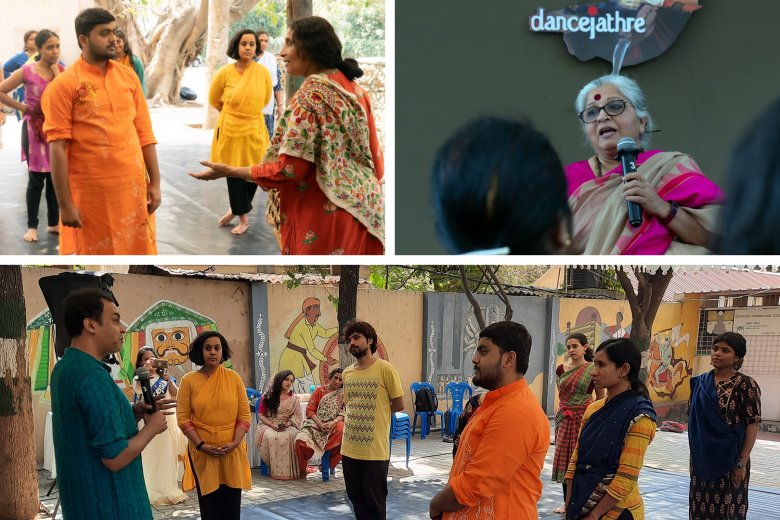 Vaibhav Arekar took a daily routine, like rushing to the office, thinking about some excuse, and then put it into the dance context of Radha running late to see Sree Krishna, who is waiting for her. The exercise emphasized being specific about what one imagines, rather than starting with something abstract. Being a trained theatre person, Vaibhav explained the techniques followed in theater and film, which could be useful when it comes to getting connected with a character. "Rusli Radha, rusla Madhav...", the first lines of the Marathi poem was used to demonstrate the importance of subtle changes when portraying characters. The concept of angasudhi explained as a singer hitting the right notes during rendition was also insightful. The Kuchipudi workshop by Vyjayanthi Kashi also was on similar lines, and she structured her workshop around the question of even after training for several years if a dancer couldn't move forward in the way one perceives the art, what's the point. To highlight this, she took the sloka "Angikam bhuvanam yasya..." and asked the participants to elaborate, beyond merely translating it to gestures. Without being mechanical and transforming right from the namaskaram, adding meaning to adavus by contextualizing them, and using padabhedas while practicing, all in the perspective of taking one's dance to the next level, formed the rest of the content of her workshop. The workshop on saatwika abhinaya by Minal Prabhu was like an icing on the cake. She explained how saatwika adds deeper meaning to what is conveyed through angika. The participants were asked to explore their own imaginations and by giving insights and feedback she explained how it could be well used to reflect the characters in a better way. Active sessions The workshops segment was not all about classical dance. There were fun-filled active sessions and also informative sessions. The Afrofit workshop by Jothi Viknesh was electrifying, whereas the folk workshop by Vaidegi S (in the absence of her guru Mysore B. Nagaraj) was a joyful experience. The body fitness workshop by Bijayini Satpathy and contemporary dance session by Prashanth were on the lines of understanding one's body better. Archana Kumar introduced the Flamenco dance in her session, whereas Mahabala Kerekodi's Yakshagana jewelry session gave a chance for the participants to familiarise with the aharya of the age-old traditional theatre form. Exhilarating performances 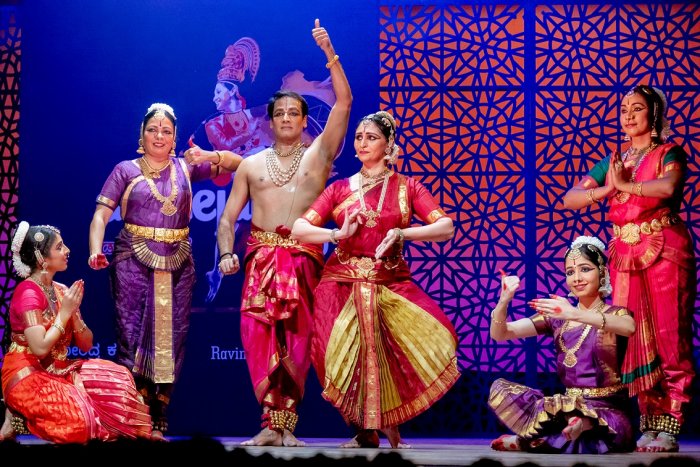 Sathyanarayana Raju, Soundarya Srivathsa and group The two evenings of the festival had performances by seasoned artistes. Again, none of them were full-fledged recitals, all were group presentations, and were in the timeframe of 45 to 60 minutes. However, none of this seemed a limitation for the dancers, and they all were up to the task of making an impression. The inaugural program was a Bharatanatyam group presentation by Sathyanarayana Raju, Soundarya Srivathsa, and their disciples. The team commenced their recital with a Ganesha sthuthi in raga Gambheera Nattai. The main piece was "Endaro mahanubhavalu...", a celebrated work of Tyagaraja in praise of Lord Rama. It was a rather simple and straightforward approach, the team came together mostly for the dance sequences, while Sathyanarayana Raju and Soundarya role played recreating some of the instances from the epic Ramayana. What made those portions captivating is the way it was all conceived, and without unnecessarily elaborating or overdoing, they were able to bring out the essence, touching the soul of the characters. One instance was the way Sathyanarayana portrayed Sabari. Also, the way he transformed from the ailing father watching his son leave to the furious demon king fighting Rama in one quick turn was so exhilarating. Soundarya mostly had to complement, and she has done it effectively. They had the accompanying support of D.S. Srivathsa in the vocal, S.V. Balakrishna on the mridangam, and Karthik Sathavalli on the flute, adding more dynamism to the recital. Odissi group recital by Gunjan Dance Academy, headed by Meera Das, was the second performance of the evening. Sasmita Panda, Priyanka Jena, Bidya Biswajeeta, Swarnamayee Behera, Shibani Parija, and Sweekriti Das joined her on stage, and they all were equally proficient. After starting with a mangalacharan inspired by the 'Pahandi Bije' of Lord Jagannath, the team presented two more choreography pieces namely 'Moods of Rhythm' and 'The Rain.' The dance sequences were impressive, and there were elements, like the depiction of the chariot in the first piece, and the peacock dance in the last, which were exciting and entertaining. On the other hand, it was all dance, and maybe having an item focusing on abhinaya in between would've further enhanced the recital. 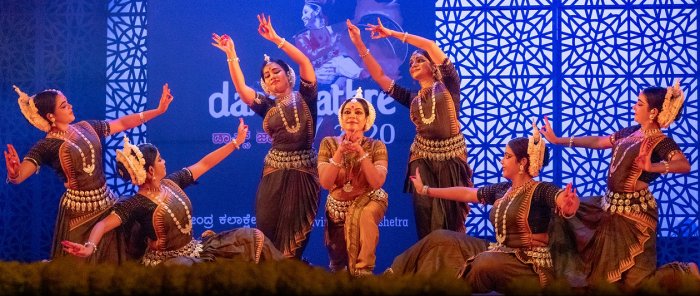 Gunjan Dance Academy 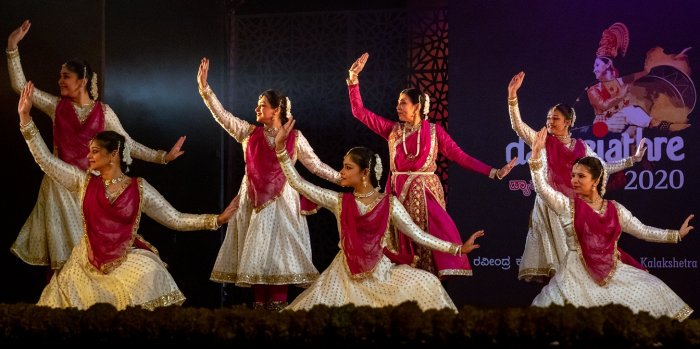 Maneesha Nrityalaya Maneesha Sathe and her team of dancers from Maneesha Nrityalaya - Tejaswini Sathe, Madhuri Apte, Neha Muthiyan, Vallarie Apte, Moushami Jaju, and Vaishnavi Nimbalkar - presented Kathak afterward, and even in the limited time, they were able to bring in the variety. Like the Odissi team, here also the members were proficient enough to share the stage with their guru, and it certainly uplifted the quality of the performance. The starting dhrupad and the tala compositions set to 14-beat cycles that followed were impressive for its choreography and execution. The storytelling aspect came into light in the saadara piece by the pioneer of Kathak, Bindadin Maharaj, based on the battle between Rama and Ravana, sancharis illustrating stories connected with Shesha, the serpent. Drut tritaal presented in jugalbandi pattern was the concluding piece, and they all together made it appealing as well. A slice of Kuchipudi 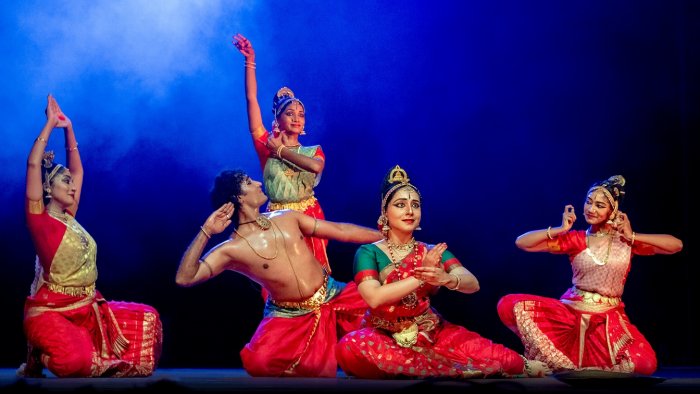 Shambhavi School of Dance The second day saw an overall improvement in lighting and stage setting as well, further enhancing the performances. At first, viewers were treated to a scintillating Kuchipudi by Shambhavi School of Dance, headed by guru Vyjayanthi Kashi. Prateeksha Kashi was in the lead along with Gururaju N, Mahalakshmi B.H, Diksha Shankar, Aishwarya Paramesh, Chaitra K, and Krishna. The highlight of the recital was indeed the choreography of Vyjayanthi Kashi, and it was all a visual treat filled with exciting moments. They began their recital with the Muthuswami Dikshitar composition "Mahaganapathim..." in praise of Lord Ganesha. Some stage props were also in good use to enhance visual aesthetics. Annamacharya's "Adhivo alladhivo..." in Madhyamavati visually described the adobe of Sri Hari, ornamented by the ten thousand hoods of Sheshanaga. Proving their skills of dancing on the brim of the dance plate, the dancers came well together in the tarangam piece "Neelamegha sareera...". A unique dance number, interpreting the Marathi abhang in praise of Panduranga, aka Vithala, was the concluding piece. An experience to remember 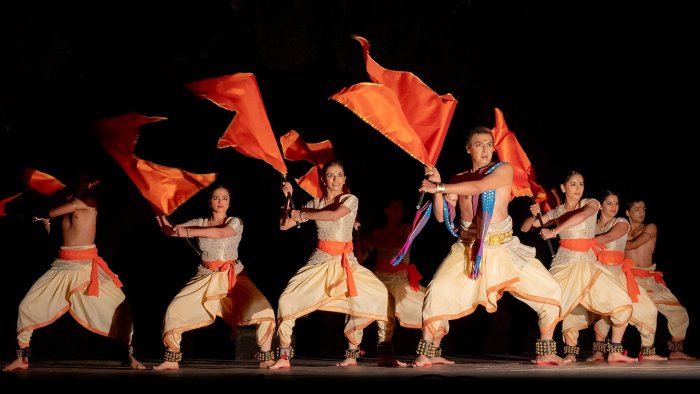 Shrimant Yogi It wouldn't be wrong to say that this edition of Dancejathre will be remembered for 'Shrimant Yogi', if nothing else. The thematic dance production was a fitting finale by Vaibhav Arekar and members of Sankhya Dance Company - Eesha Pinglay, Ruta Gokhale, Deepika Potdar, Mrunal Joshi, Sachhidanand Narayankar, Gautam Marathe, Radhika Karandikar, Aditi Paranjpe, and Shruti Ranade. The production traces the life story of Maharaja Shivaji of the Maratha clan. However, rather than telling the story of the warrior king, the associated emotions of different life situations of Shivaji was presented, using a blend of theatrics and dance, well complemented by thoughtful light design and use of props. The opening scene gave a glimpse of the period when Shivaji was born, a time when the Mughals were in power. How he was influenced by the epics Ramayana and Mahabharata, listening to his mother Jijabai during his childhood was shown afterward. The rest of the portions showed the rise of Shivaji as the Chathrapathi (emperor), and later gaining the stature of Shrimant Yogi, who had all earthly pleasures yet chose to live the life of a saint. The technique and approach varied scene to scene without stretching them more than what was required, keeping the audience engaged throughout. All the dancers were lively and performed with the much-needed vigor and energy. Their acrobatic skills were also used well in many situations. Vaibhav Arekar, also the director and choreographer, was captivating as he moved from one role to another, mostly presenting the different stages of the title character. The scenes that required a more sensible approach, like the phase change of a Chathrapathi to a Yogi, were remarkable. The music score with minimal to no lyrics by Manoj Desai and Karthik Hebbar helped in abundance in creating the mood. Light design by Sushant P. Jadhav was truly immersive, with even shadows and darkness put into good use. The effective use of stage space and stage props adding dimensions also deserves mention. The festival took place at different venues on the campus of Ravindra Kalakshetra, in Bengaluru, on the 8th and 9th of Feb 2020. Dr. Hareesh N. Nampoothiri is a visual design consultant by profession, an art lover by obsession and an author, writer, photographer, editor, lyricist, and director by passion. He is also the founder and chief editor of Artograph, a bimonthly e-magazine on arts. |